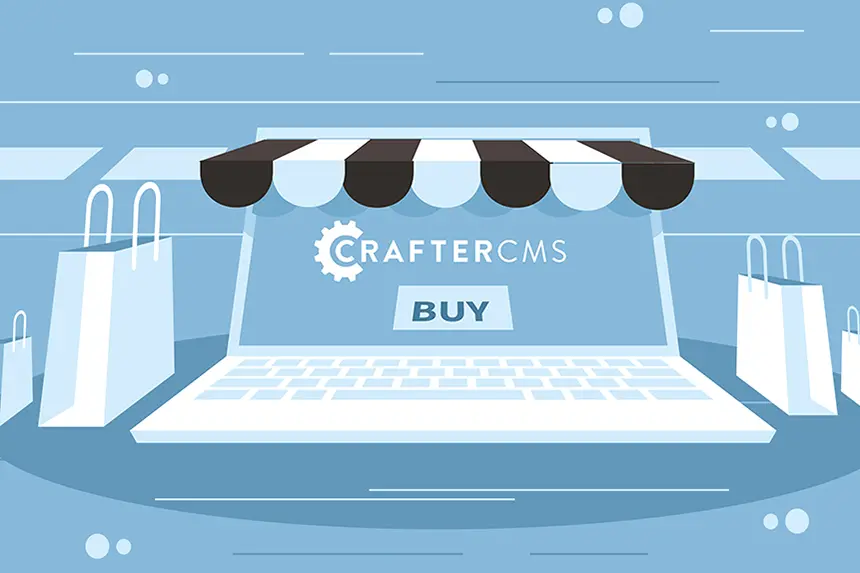The Future of eCommerce with CrafterCMS

Sara Williams

Predicting the future is always tricky. Yet sometimes, with access to the correct data and an understanding of what’s trending, predictions can be pretty accurate. Consumer behavior has changed, and customers no longer view a brick-and-mortar store as the only way to get their shopping done.
Now, eCommerce has fully established itself as one of the vital consumer preferences for shopping. The numbers reflect it, too, as, according to Statista, retail eCommerce sales are expected to reach $6.4 trillion by the end of 2024. While brick-and-mortar stores aren’t going away anytime soon as consumers still enjoy the experience, businesses need to ensure that they have the proper infrastructure to accommodate the need for digital shopping.
Brands are turning to headless commerce to do just that since it can help manage the changing consumer habits and reach multiple digital touchpoints. In this article, we’ll explain how headless architecture enables headless commerce, the benefits compared to traditional commerce, and how CrafterCMS leverages headless commerce to drive innovation.
Headless Commerce vs. Traditional Commerce
Headless commerce is the separation of the eCommerce backend layer from an eCommerce store’s front-end presentation layer. This decoupling of layers enables brands to create custom front ends that can be used across multiple devices and digital touchpoints.
This tight coupling can place limitations on brands in traditional commerce, restricting them to specific software frameworks and only one or two channels. However, we now live in a world driven by content-rich applications, meaning that the basic features available in traditional eCommerce platforms are no longer enough.
Challenges of Traditional Commerce
- Multichannel options are challenging, if not impossible.
- There is limited flexibility in terms of content promotions, the ability to create subscriptions, and more.
- There is plenty of friction between marketing and merchandising teams.
The underlying architecture for headless commerce is the same as for a headless CMS. The backend layer connects to any frontend through the use of APIs and microservices. This enables brands to be more flexible and adaptable in how they create customer experiences. It also provides framework agnosticism for developers, allowing them to choose modern frameworks to get the job done.
Benefits of Headless Commerce
- Increased personalization: With a headless commerce platform, brands can personalize content for each customer instead of providing the same blanket messaging across all channels.
- Omnichannel experiences: Content can be delivered to multiple channels and connected seamlessly, allowing customers to start shopping on one device and finish on another without missing a beat.
- Speed and cost savings: Headless commerce platform users can rely on one interface to manage everything, saving them time and saving the business costs rather than using multiple systems for every channel.
Headless Architecture for CMS and eCommerce
Headless architecture removes the monolithic services that plagued traditional commerce platforms and breaks them down into smaller microservices. As a result, support for multiple channels is built-in by default and only needs to be connected via APIs. This also makes scaling and distribution much more straightforward and enables a best-of-breed approach that allows brands to integrate the services and third-party applications they want to, without the restrictions placed on them by monolithic suites.
A headless+ CMS like Crafter can provide the headless architecture ideal for combining content and commerce to facilitate the next level of eCommerce that customers are demanding.
Crafter provides the tools for companies to create dynamic omnichannel and personalized experiences that are easy to maintain. Developers can use modern software frameworks, and businesses can rely on an elastic architecture that facilitates scalability. Using GraphQL, Crafter enables a single API call to a backend to retrieve eCommerce product data as well as marketing content and deliver it to the browser, a huge performance improvement over typical simple headless approaches.
However, Crafter also provides in-context editing for all channels and can fit directly into existing CI/CD workflows and DevOps processes. Crafter also innovates with DevContentOps, making it easy to move code and content between environments, supporting parallel development, and facilitating seamless collaboration between content teams and DevOps teams.
The Role of Progressive Web Apps
Having the right architecture is critical for the future of eCommerce, especially as the new standard has become a mobile-first approach. Mobile devices account for 50% of the total web traffic on the internet. Brands that recognize that are also leveraging progressive web apps (PWAs) to create unique mobile experiences, drive revenue and reduce maintenance costs.
PWAs are mobile sites that look and feel like a native mobile app. This means that whether a user is browsing on an iPhone, Android or another mobile device, they can have the same enjoyable experience they would have using a native web app, and the companies that create these PWAs save on development costs.
Here are some of the benefits of PWAs:
- Shorter time to market
- Lower customer acquisition costs
- Increases in engagement and conversion rates
- Reduction in bounce rates
- Boost in SEO rankings
In order to build PWAs that provide a great user experience, brands can start with headless architecture. Next, they’ll need to choose an application development stack. Many developers enjoy using JAMstack because of how well it combines with headless architecture due to the flexibility of JavaScript frameworks. JAMstack works incredibly well with Crafter and enables developers to leverage Crafter’s elastic scalability and cloud-native infrastructure to meet the demands of today’s content-rich eCommerce environments.
Take Your Commerce Headless with CrafterCMS
Headless commerce represents the future of eCommerce, and brands can use it to meet changing customer needs. For those businesses hoping to get started with this new approach to commerce and ditch the traditional methods that limit creativity and flexibility, choosing a suitable CMS is essential.
Learn more: Read our case study CrafterCMS Enables E-Commerce for Bookselling Leader
Crafter’s headless architecture is ideal for bringing content and commerce together. With its API-first approach, developers can connect the third-party applications that help improve the customer experience and connect to various frontends using the frameworks and modern technologies that they prefer. Crafter integrates with leading eCommerce platforms, PIM, ERP systems, and more to facilitate headless commerce entirely.
Plus, CrafterCMS doesn’t leave marketers out in the cold. With drag and drop page building, and in-context editing and previewing, creating content for multiple channels and digital customer touchpoints is easy. If you want to learn more about how Crafter is building this future, watch our webcast: Future of E-Commerce: Progressive Web Apps, JAMstack, and Headless.
Related Posts

Websites Are Dead?

Mike Vertal

No-Code Experience Building for Marketers & Designers

Amanda Lee

The Future of Web Experiences: From Browsing and Searching to Conversational AI

Mike Vertal

Is Your CMS MACH-Ready? A Practical Guide for Enterprise Architects

Sara Williams
Related Resources
-

CrafterCMS at eBay: The Universal Content Platform for eBay.com
Webcast
-

Personalized Digital Experiences for a Cruise Liner
Webcast
-

Introducing CrafterCMS v4.0
Webcast
-

Modernizing Video Delivery and Content Management at CPAC, A Canadian Nationwide Broadcaster
Webcast
-

Building React Apps on a Headless CMS
White Paper





